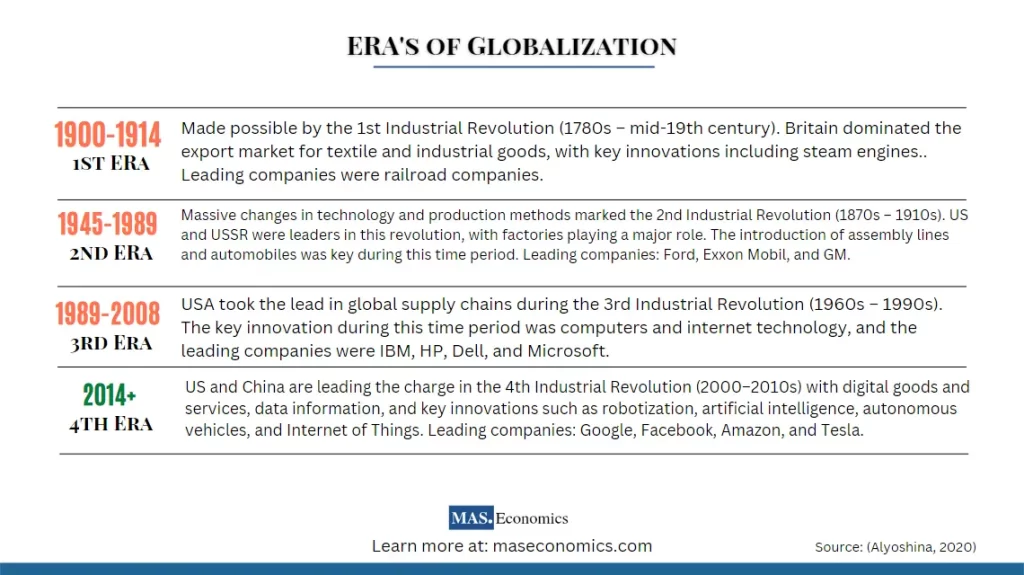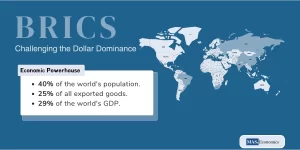Globalization highlights the increasing influence of business and trade across national borders. It has far-reaching implications across trade and finance in different world regions.
Nearly half a century ago, the advent of globalization beckoned with an increase in the number of connections between various economies, some of which have been turned into positive opportunities. Many developing countries such as Brazil, China, and India have experienced economic emancipation by harnessing the opportunities of globalization while implementing measures to overcome the negative externalities associated with this trend. The positive impact on these economies has been significant.
The World Bank estimates that if all developing nations had achieved the same level of income per capita as developed countries, they would be $1 trillion richer today than they are. It also states that the current gap will widen further due to population aging and increasing life expectancy.
Now you know what globalization is, but before we deep dive into the roots of globalization, it is essential to introduce to you different types of globalization, including economic, political, and cultural globalization.
Types of Globalization

Economic globalization
Economic globalization refers to the increasing integration of international trade and investment. This has been driven by advances in technology, such as increased connectivity through the internet and faster shipping methods, as well as policies that have led to more open markets between countries. As a result, goods can be produced at lower costs in one country and sold in another without requiring any import tariffs or other trade barriers. This allows companies to compete on a global scale, resulting in greater efficiency for businesses and cheaper prices for consumers.
Political globalization
Political globalization involves strengthening ties between nations through various agreements and institutions. For example, there are many international organizations that work together to achieve common goals and resolve disputes, such as the United Nations (UN), North Atlantic Treaty Organization (NATO), and World Trade Organization (WTO). Additionally, nations often enter into treaties regarding shared interests such as trade agreements or climate change accords. These policies help ensure greater cooperation between countries and a more united front on issues that affect all of humanity.
Cultural globalization
Cultural globalization is characterized by increased exchange among different societies around the world. This can take place through travel and tourism, migration between countries, or through mass media like television and film. As people come into contact with other cultures, they may adopt new customs and traditions for themselves, or even create entirely new cultures by combining different elements from different places. This can lead to a more tolerant, accepting and diverse world.
However, in this post our focus will be on economic aspect of globalization but it is important to understand that economic globalization is not just about trade agreements or multinational corporations – it encompasses all areas of society. This includes factors like the movement of people, ideas and information around the globe. This process is often quite complex and requires us to think about not only what we are gaining from these connections, but also what we are sacrificing in order to forge them. However, there are many benefits to economic globalization as well, including increased access to goods, services and knowledge that may not have been available otherwise. In order to fully understand this process, it is important to examine both sides of the coin.
Overall, the different types of globalization each have their own benefits and drawbacks. However, by working together on shared goals such as global economic growth, political stability, and cultural diversity, we can help ensure that the positive effects of globalization outweigh the negative ones.
History of Globalization in Phases
The history of globalization dates back to the Indus Valley Civilization, coastal Sumerian cities established throughout the Persian Gulf and southern Mesopotamia. However, globalization accelerated in the mid-twentieth century due to technological advancements—international cooperation, facilitated by organizations such as the United Nations, aided in the process of globalized societies.

First Phase of Globalization
The first Industrial Revolution emerged a new era of international trade and globalization. International trade changed how countries traded with each other, moving from trading predominantly finished products to trading the components used to make those goods. This allowed for global competitiveness and quality control of products; however, it also gave countries with manufacturing processes more power.
This transformation began around 1780 when trade barriers were removed, and factories were built to mass produce goods instead of doing work by hand. As a result, countries started to trade more with each other as they could produce goods much faster and more efficiently.
The role of multinational corporations also increased during this period, which further enabled countries to connect through business practices and economic growth. It was a significant turning point that helped shape today’s modern global economy. This was a major shift in global integration and how countries traded with each other both on a national and international scale.
Another important aspect of this transformation was multinational corporations’ role in promoting global trade. As companies expanded beyond their national economies and into other global markets abroad, they were able to help connect different countries through business practices and economic growth. For example, established corporations such as Mcdonald’s are now present in virtually global marketplace, making it easier for consumers from different countries to purchase products they are familiar with. Undeniably, multinational corporations have played a key role in shaping today’s global economy and fostering international trade between countries.
However global economy was globalized in this sense, but it was wildly uneven globalization. Developed countries brought manufacturing processes to less developed countries, taking advantage of lower wages and helping develop local infrastructure through foreign direct investment (FDI).
Overall, the first Industrial Revolution was a critical turning point in the history of globalization as it opened the global market for many developing economies to trade with advanced economies on a global scale. Through this international cooperation, they have achieved technological progress and economic development.
Second Phase of Globalization
The global economy began its second phase at the end of World War II. While global trade continued to grow throughout the war, global finance was thrown into disarray.
The 1944 Bretton Woods conference was held to set global financial rules, and after its conclusion, it became clear that the world economy would be shaped by global finance.
Post-war globalization was built on economic institutions such as the World Bank (WB), the International Monetary Fund (IMF) and global agreements on global finance, trade, defense, and development. These global institutions were designed to maintain global stability in international affairs so that globalization could continue smoothly.
Third Phase of Globalization
The third phase of globalization began with the financial crisis of the late 2000s, a period of global financial instability.
The wave of emerging market growth throughout the Decade of Emerging Markets had halted by 2010, and global growth was slowing down.
The global institutions built up in the previous globalization had mainly been blamed for not responding strongly enough to the global financial crisis, so there was a lack of faith in global finance and global institutions.
This lack of faith in global finance led China to start pushing an alternative idea of globalization through global infrastructure and standards. So China set out to invest in global infrastructure and connect global markets, hoping to globalize the Chinese economy and simultaneously create a more sustainable and balanced global economy.
Current global trends show that global trade declines domestically after decades of growth while processing trade (where inputs are imported for processing and then exported) increases. Global finance is also moving away from globalization, with global banks reducing their global foreign assets by $1.5 trillion since the global financial crisis.
This period of global instability has shown that global stability must be maintained through global institutions, shared values, and common interests.
Fourth Phase of Globalization
The fourth phase of globalization 4.0 of the future will be globalization for all, not just for developed countries.
Digital Globalization
Digital Globalization is a new type of globalization mainly about the digital flows spreading information, ideas, and innovations worldwide.
This makes it easier for more people to participate in the global economy and strengthens the process of digital globalization. These data flows to ensure that global economic, financial, and social connections keep growing and strengthening.
So, global digitalization is gaining speed, and it is no longer just governments, large multinational corporations, and major financial institutions at the center of it. Small businesses, entrepreneurs, app developers, freelancers, and even individuals can now take part directly on digital platforms that reach the entire world.
Artificial Intelligent and Internet of Things
Digitization and artificial intelligence (AI) are the successive revolutions of globalization. One key driver of Globalization 4.0 is the emergence of intelligent machines that can make decisions independently.
These machines can gather data from various sources online, analyze it for patterns, and use this information to inform decision-making. This rapidly growing interconnectedness between people, devices, processes, and services through the internet of things (IoT). The use of objects of the internet of things, includes intelligent and connected devices that create and manage data as it makes a business interactive. This interconnectivity allows companies and individuals to access data, collaborate, and make intelligent decisions at unprecedented speed and scale.
As a result of these technological advancements, Globalization 4.0 is ushering in an era of greater automation, efficiency, connectivity, and intelligence.
Globalization has connected us and changed how we live, but it also puts us at risk of spreading disease. Integration of the world economy has facilitated the spread of the Covid-19 pandemic.
Benefits of Globalization
Globalization has had both good and bad effects. It has lifted many people out of poverty, but it has also created new inequalities and insecurities.
As we debate the pros and cons of globalization, it is important to remember that it is not an all-or-nothing phenomenon; there are different degrees of globalization and different approaches in which it can be managed to maximize the benefits and minimize the costs.
Increased Economic Growth
One of the most important advantages of globalization is that it has led to increased economic growth. It has increased trade between developed and developing countries. This has led to the production of cheaper goods for developed countries and increased wages for developing countries. Globalization has made markets more efficient by making them more competitive and forcing businesses to be more creative and efficient to stay in business.
Improved Living Standards
Along with economic growth, globalization has also helped to improve living standards in many parts of the world. Thanks to increased trade, people can access various goods and services at lower prices. In addition, globalization has led to increased investment in education and health care, which has further improved living standards.
Reduced Poverty
Another essential benefit of globalization is that it has helped to reduce poverty worldwide. In recent years, extreme poverty (defined as living less than $1.90 per day) has declined significantly in many parts of the world, thanks mainly to economic growth generated by globalization. Between 1990 and 2010, it helped more than 1 billion people escape poverty.
Specialization, efficient markets
Globalization has created new opportunities for specialization. Businesses can enter new markets relatively quickly by dividing the labor market and focusing on specific areas of expertise.
This is because they are not competing with larger entities with strong control over their customers. Instead, they can focus on delivering a specific service or product that meets the target market’s needs.
For example, a company that is good at making parts for car engines does not have to make whole cars to compete with more prominent companies like Toyota and Ford. That means their resources, such as their staff and investments in technology, can be and will be specialized more.
Reduce Consumer Product Prices
Globalization’s new business opportunities and specialization eventually lowered consumer product prices. For most people, the most visible effects of globalization are likely to be the effective reduction in the costs of consumer goods – and, as a result, the radical increase in living standards.
Focus on Research and Development
Globalization has allowed companies to focus on research, development, innovation, and capital. Companies have become more specialized, which has increased human capital and skilled jobs. Moreover, in the long run, the rate of technological advancement determines how prosperous a society becomes.
Challenges of Globalization
A sizeable number of developing countries are yet to experience such positive influence from globalization. In these countries, globalization has left debris of a worsening state of the economy, labor exploitation, a decline in local production, and, worst of all, an increase in inequality.
The exploitation of workers in developing countries
Many anti-globalization economists argue that the benefits from trade liberalization may not necessarily accrue equally across different groups of people or even societies. They point out that some sectors benefit more from free trade than others. For example, many developing countries like Brazil and China have benefited significantly from globalization by adopting market-oriented reforms. Foreign direct investment flows into emerging markets have risen to account for about half of total outward FDI, leading to increased living standards in the two countries.
Create Inequality
Furthermore, it is argued that the gains from trade liberalization do not always trickle down to those who need it most. Evidence shows that the poor tend to suffer disproportionately when international trade becomes freer. For instance, a Harvard University study discovered that India’s poorest 20% of households suffered economic losses due to world trade organization membership. Another study showed that the share of Indian exports going to low-income consumers fell sharply following its accession to the world trade organization.
Job loss in less advanced economies
Globalization has been criticized for causing job losses among workers in less advanced economies. This phenomenon was first observed in North America and Europe manufacturing jobs, where automation technology made production cheaper abroad.
Creates winners and losers
Another criticism against globalization is that it creates winners and losers within each economy. While some businesses gain from greater competition, others lose. In addition, globalization tends to create inequality within countries. Some regions become wealthier while others remain poor. Finally, globalization often causes environmental degradation. Critics say that the negative consequences outweigh the positive ones.
Environmental and Climate Changes
Globalization has had several negative effects on the environment and climate change, including increased pollution and the destruction of natural habitats.
One significant impact of global integration is that it leads to increased greenhouse gas emissions through the burning of fossil fuels to transport goods between countries. This increase in international movement can significantly impact global temperatures, warming our planet and contributing to climate change.
Another adverse effect of globalization is that it encourages the overuse and depletion of natural resources such as forests, rivers, and oceans.
Clearly, the negative environmental impact of globalization highlights the importance of finding sustainable alternatives that can reduce our dependence on fossil fuels and protect natural resources. We can help protect the environment and prevent further damage to our planet.
Case Study of Globalization Pakistan, China, and India
The Chinese economy proliferated from 1978 onwards as its leaders sought to transform their nation into an industrialized power. The reforms included opening up trade and investment relations with foreign nations, liberalizing prices for goods and services, establishing special zones where market forces would be given free rein; allowing greater competition among businesses; encouraging entrepreneurship, and promoting technological innovation.
These changes led to rapid growth in output per capita and real income. In addition, they helped reduce poverty levels and improve healthcare conditions. However, critics say these positive trends are being reversed due to the recent global economic slowdown. This has resulted in a decline in export demand and domestic consumption. Furthermore, there has been a rise in unemployment rates and inflationary pressures.
In contrast, other developing countries like India and Pakistan have failed to reap similar gains despite adopting policies similar to China’s. A significant reason behind this failure is that most Indian industries were state-owned at independence in 1947. As a result, it took decades before private sector firms could take off. Similarly, Pakistani industry remained under government control until the 1970s, when the military regime allowed limited privatization.
Another reason, India and Pakistan also differ from China in their political systems. China is ruled by a single party that is highly centralized and focused on economic development, enabling the country to implement policies quickly and efficiently. In contrast, India and Pakistan operate under complex multiparty democracies that can slow implementation and change policies. This has hindered the countries’ ability to adapt quickly to changing economic conditions, resulting in slower growth rates.
However, the country’s industrial policy continued to favor large public enterprises even after that. Thus, both countries did not experience any meaningful structural transformation during the last four decades.
In short, here are several reasons why certain countries do better than others in terms of benefiting from globalization.
-
- First, the quality of institutions plays a crucial role in determining how well a nation performs economically.
-
- Second, the size of domestic markets matters because larger markets allow companies to produce goods cheaply without incurring high transportation costs.
-
- Third, technological progress helps boost productivity and thus increases competitiveness.
Covid-19 Pandemic effects on Globalization
Globalization is one of the major forces driving global economic and cultural change. However, with the emergence Coronavirus disease of 2019 (Covid-19), a global pandemic, many aspects of Globalization are now facing severe challenges.
One of the critical effects of Covid-19 is its impact on cross-border travel and trade. Global air traffic has plummeted due to government flight restrictions in response to Covid-19. At the same time, cross-border trade has also been affected as countries close their borders or restrict certain goods from entering their territory. This disruption to global supply chains will have far-reaching consequences for businesses worldwide as they struggle to keep up with changes in demand due to reduced production.
The Covid-19 pandemic added fuel to the trend away from Globalization. The World Trade Organization’s there was a decline of between 13% and 32% in world trade in 2020; a much more than expected fall in world GDP.
The future of Globalization is uncertain in the wake of the recent covid-19 pandemic, which has wreaked havoc on global trade and travel. One factor that could impact Globalization going forward is consumer sentiment. With so many countries now grappling with Covid-19, consumers may be less inclined to support businesses heavily reliant on international trade and travel. Instead, they may choose to buy local products and services. In addition to consumer sentiment, geopolitical factors will likely play a significant role in shaping the future of Globalization.
For example, some countries may begin to enact a more isolationist approach as they seek to insulate themselves from the effects of Covid-19. This may result in a drop in global trade and overall economic growth.
However, digitization has become a basic need in the fight against the Covid-19 crisis. It plays an unprecedented role in maintaining economic and social activities and recovering industries and business activities.
To determine the geo-location of sick or those are at-risk people through artificial intelligence and big data, for example. Countries, such as Israel and South Korea, are using digital technologies to curb the Covid-19 infection. In many countries, digital technology and its applications are also extensively used to promote remote work and e-learning initiatives. Digital technology has, therefore, a crucial role to play in reducing the impact of the Covid- 19 crisis.
In short, one thing we can be sure about in a post-Covid climate is the digital future.
Conclusion
Globalization has been one of the most important forces shaping our world over the past few decades. While it has brought significant benefits to many countries, its impact has not been uniform. Developing countries that have taken advantage of globalization by implementing the right policies have seen their economies grow rapidly, while others have failed to benefit from this trend. And with the emergence of Covid-19, a global pandemic, many aspects of globalization are now facing severe challenges. However, globalization is not dead!
We will continue to monitor these developments and keep you updated on the latest research and findings. To stay ahead of the curve with our blog – sign up for our email list today
References:
Freeman, R. (2022). Doubling the global workforce: the challenges of integrating China, India, and the former Soviet block into the world economy. Doubling the Global Work Force”.
Alyoshina, Irina. (2020). Artificial Intelligence in an Age of Digital Globalization. 26-30. 10.17747/TEDS-2019-26-30.
Shrestha, N., Shad, M. Y., Ulvi, O., Khan, M. H., Karamehic-Muratovic, A., Nguyen, U. S. D., … & Haque, U. (2020). The impact of COVID-19 on globalization. One Health, 11, 100180.
Steger, M. B. (2017). Globalization: A very short introduction (Vol. 86). Oxford University Press.
Stiglitz, J. E. (2007). Making globalization work. WW Norton & Company.
Freidman, T. (2005). The world is flat. New York: Farrar, Straus and Giroux, 488.
Rogoff, K. (2003). Globalization and Global Disinflation. Retrieved from https://scholar.harvard.edu/files/rogoff/files/rogoff2003.pdf
Rodrik, D. (1998). Globalisation, Social Conflict and Economic Growth. The World Economy, 21(2), 143–158. https://doi.org/10.1111/1467-9701.00124




